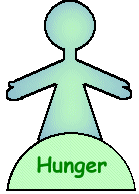Problems- Street Children &
Orphans:
Worldwide, an estimated 100
million children have been abandoned and live either on the streets or in
orphanages. Eighty percent of these children live in the third world. And
while street children are considered to be no different from vermin,
orphanages in some regions allow children to live no better. Below is a
chart which shows some examples of abandonment of children in various
countries:
|
Abandoned Children
Worldwide |
|
Country |
Problems |
| Columbia |
More than 30,000 children are
abandoned because of poverty; some are sent to live and work on the
streets, while others are abandoned completely. |
| China |
There are roughly 1-3 million
orphans for only 40,000 orphanages. Still, 2/5 of all children in
orphanages die. Almost all of these orphans are girls or boys with
disabilities, and are treated poorly with over five children to a
small crib, tied to posts, left unattended, or left to die when
sick. |
| Egypt |
Abandoned children are left to
die in hospitals or receive no charity at all, assumed to be born
out of wedlock. |
| Guatamala |
As is the case throughout Latin
America, there is a large population of street children who are
mistreated by police, society, or even targets of
massacres. |
| Hungary |
There are
more than 22,000 children abandoned(some in
orphanages), most of which are children of Gypsies and
up for foreign adoption only(unwanted in the country). |
| India |
There are
over 18 million street children in India, and orphanages throughout
the country are filled. Many of these children are also unwanted girls.
India is considered to have the largest population of orphans in
the world, and in the most need of help. |
| Romania |
There are nearly 2,500 street
children, and roughly 100,000 children in orphanages or private
shelters. However, over 80% of the children still have ties to
their parents. |
| former Soviet Union |
More than 650,000 abandoned children are being
cared for in state orphanages, though there is also an abundant
presence of street children. Based on Moscow studies, one out of
three children in the orphanage system die before adolescence.
Two out of three orphans commit crimes and many girls
become prostitutes by the time they are teenagers, and 10% who make
it to that age commit suicide. |
| Zambia |
More than 360,000 children(10% the total
population) of have lost one parent or both to AIDS and
AIDS-related diseases. This is very much the trend throughout
Africa. |
| Zimbabwe |
Hospitals get an average of 20
babies abandoned daily. |   In Calcutta, street children search through
trash for plastic to sell so they will have money to eat
with. In Calcutta, street children search through
trash for plastic to sell so they will have money to eat
with.
Children living and working on the streets is a wide-spread
phenomenon throughout the third world. It is estimated that there are 200
million street children in the world today, many of whom are not considered to
be abandoned because they are still tied to their families. The number
one cause of children on the streets is rapid industrialization
and urbanization, coupled with economic problems. Family or social problems
is another reason, usually also coupled with family living and
economic conditions. Many children are sent to the streets because the
family cannot afford to support them; on the streets, the children will be
forced to work, and that brings an extra income to the family with one less
mouth to feed. Many children, such as those in the Philippines or Romania(80%)
still have parents, though they live on the streets.

Graph created from data in "Causes and characteristics of the street child
phenomenon: a global perspective"(8) |
As seen in the last section, abuse is a growing
concern for children in the third world. In Nepal, where 60% of the
population is below the poverty line, street children admit that
abuse/neglect is the number one reason for their situation (as seen
on the graph). The second most popular reason was the
attractiveness of city life; street children form very
tight groups, with a social structure of their own. The fact
that most reasons given for becoming a street child are
socially-oriented suggests that though children have basic needs,
they are not even receiving the basics of love and caring from their
family surroundings. This data comes from a 1990 study in Kathmandu,
Nepal, which also looked at some of what the street children suffer.
Many are: left without families and parents, involved in antisocial
activities and theft, struggle and beg to meet basic needs such as
food, and exploited by employers.
|
On the streets, the children face many hardships and suffer
from a variety of fates. In other parts of the world, street children are:
sold into industries (sweatshops, sex industry), abused by authorities or
gangs, lonely and neglected and suffer psychological damage, search for
garbage to eat or sell, malnourished and growth stunted, addicted to
drugs, and uneducated. They are left with little means of living, and
littler chance to advance themselves or break out of the cycle. In
Nairobi, Kenya, there were an estimated 88,000 street children in 2001,
with numbers growing by 10% every year. 60% of street boys have health
problems associated with taking drugs, 30% of street girls have HIV/AIDS,
and 90% of street girls have some sexually transmitted disease. And as
they are uneducated and live in the poorest of conditions, heath problems
are only more likely to spread throughout the groups of
children.
For the third
world’s orphans, life is not much better. The many reasons children become
abandoned have previously been discussed to some extent (poverty, cultural
views, social problems, abuse/neglect, etc.) However, there are additional
reasons children become orphans. There are 13 million children orphaned
due to AIDS. The two major reasons for this are one, having one or both
parents die of AIDS, with no one left (or no one willing) to care for
them, and two, testing positive at birth for HIV/AIDS (contracted from
parents). In many cases, children give a “false-positive”) but by the time
this is discovered, the children are already abandoned. Another cause of
orphans in the world is warfare. Children can lose fathers who are
fighting, or whole families who are caught in the crossfire. Children can
also be separated while on the run, or at refugee camps, losing families
to disease. Many children who have been orphaned are left to the streets.
But quite a few are taken in by orphanages (the numbers and percentages
vary greatly throughout the world, however).
| While many orphanages make great strides in
helping, there are a number which are actually hurting the children
they house. In a Russian orphanage, conditions are described to be
quite bleak and unsanitary with not enough beds and not enough food
and restraints on most beds of children simply left to die. This is
just as shocking as many state orphanages in China where when
unwanted young girls get sick they are put in special rooms to die
rather than have treatments wasted on them. Because of the large
number of orphans, and the small number of people to care for them,
even the ones who live get little attention and little food. Girls
are frequently abused by being placed in restraints and garments to
enforce an appealing body form, making it impossible for them to
move. If not adopted (as many children are not) children must leave
the orphanages when they reach a certain age which varies from
country to country. Afterwards, they are not prepared to be adults,
having poor health and little-to-no education. There is usually
nowhere to go but the streets.
|
 | Sometimes it is not as
clear-cut as horrible abuse and neglect in orphanages.
The Frank Foundation: Child Assistance
International has recently been in the news for a “wrongful adoption”
lawsuit, involving claims that an adopted child was healthy when really it
suffered from mild mental retardation and seizures. Whatever the outcome
of this particular example, such news dissuades families worldwide from
adopting internationally. As you can see, there are also a number of
problems associated with adoption. In Russia, cultural fears that orphaned
children are imperfect prevent many able families from taking in a child.
Children in orphanages are looked upon in many countries as diseased and
deformed rejects; even in core countries, families tend to select children
from orphanages who are of utmost health rather than those with simple and
many times correctable problems. There
are also problems associated with actually getting the child. There may be
troubles in immigration, or political issues may cause a family to wait
months or years before being united with their child. One example of this
is that INS has banned adopted Cambodian children from entering the
country in order to investigate a few cases of possible stolen or sold
children. When a child is adopted, there are a number of significant difficulties
in adjusting as well. An adopted child is not used to having
personal items, or constant attention especially from adults. He is used
to having many other children around (forming tight social groups) and
sometimes sharing a bed with more than one. He might not have
an education or proper health care, he might not have ever been part
of a family unit, and if he was in a family he may have
been abused or suffer post-traumatic stress. In international adoption, cultural
differences are even more difficult to overcome, though certainly not
impossible. Obviously, there are barriers in language, food and cultural
situations. A child might not ever have ridden in a car, or seen a grocery
store, or even been to a doctor’s office.
Domestic
& Adoption Frontpage
Top of this page
Solutions- Orphanages & Adoption
Programs:

UK tennis star Mats Wilander visits
GOAL Street
Children's Program in Calcuta. |
Though there are many problems facing street
children and orphans, there are also many programs and organizations
which are making a difference in their lives. To address the
problems facing street children in Kenya, Homeless Children
International-Kenya has a number of programs. These include shelters
for street children, the CCU-Makina shelter for street girls to deal
with girl-specific issues, and outreach programs like “street
offices” to show the children there are people who care about them.
Many volunteers, good planning and support has made these programs a
success. The Street Children of Nepal Trust likewise targets
children on the street, providing them with food, health care and
even the ability to get an education. GOAL, an Ireland-based
non-profit organization works in Africa, Asia, Central America and
Eastern Europe, to support children with the fundamentals of life.
They receive funding from a number of sponsors, enabling them to
make a large impact in many countries. They have a specific program
for helping street children in Angola, Kenya, Mozambique, Ethiopia,
Sierra Leone, Honduras, Uganda and India. There are also a number of
organizations which look to help orphans, specifically. Buckner
Orphan Care International looks to improve orphanages around the
world by giving supplies, supporting foster care, providing
education, and much more. Many organizations such as the Kondanai
Village and Nyumbani provide care and shelter to Africa’s AIDS
orphans. Small NGO’s, community-cased organizations, and churches
are first to respond to this problem by supplying food & water,
finding foster families, supporting children-headed households, and
placing them in orphanages only as a last resort.
| Though there are cases of unhealthy
living conditions or abuse, there are certainly orphanages around the
world which provide well for their children. A large listing of orphanages
throughout the world can be found at
http://www.orphanage.org/. Nuestros
Pequeños Hermanos cares for thousands of children in Latin America,
providing care, structure, even education and work ethics(in the form of
daily chores such as dusting). The Sunrise Children’s Village works in
Cambodia to provide orphans with food, support, hammocks to sleep in,
culture, and even education and toys.
 
Computer classes
and lunch-time at The Sunrise Children's village
|

Group of children at Kip Keino Children's Home
in Africa which provides for AIDS orphans in housing, health, and
education.
|

Group of young
children at a Romanian orphanage who are being cared
for.
|
Adoption is the most immediate and drastic change in a child’s life.
There are many international adoption agencies which link
desiring families with orphanages. Agencies help with required legalities,
paperwork, and allow perspective parents opportunities to ask questions or
even visit their child. The Yunona Orphan Relief Fund is an example of
such a program, helping with adoptions from Russia, Kazakhstan, and the
Ukraine. It also serves as a network after adoption for current
news and fundraisers. Orphans Overseas Christian Adoption Agency is
another example, providing support for international adoptions, aid, and
more. "Intercountry adoption is a relatively recent phenomenon, which picked up
momentum after the Korean War. In 1996, Americans adopted a record number
of 11,340 children from other countries. This number represents an increase
of 1,600 children in one year. The top countries of origin in 1996
were China (3,388), Russia (2,454), Korea (1,516), Romania (555), Guatemala
(427), and India (380)"(18). This chart shows trends and
figures in international adoptions.
| Number of Adoptions per country, per
fiscal year |
| Country |
1990 |
1993 |
1996 |
| Bolivia |
30 |
124 |
33 |
| Brazil |
228 |
161 |
103 |
| Bulgaria |
3 |
133 |
163 |
| Cambodia |
15 |
1 |
32 |
| China |
29 |
330 |
3,333 |
| Colombia |
631 |
426 |
255 |
| Costa Rica |
105 |
48 |
20 |
| Dominican
Republic |
58 |
39 |
13 |
| El Salvador |
103 |
100 |
17 |
| Ethiopia |
18 |
30 |
44 |
| Guatemala |
257 |
512 |
427 |
| Haiti |
64 |
51 |
68 |
| India |
348 |
331 |
380 |
| Jamaica |
28 |
48 |
34 |
| Japan |
57 |
64 |
36 |
abridged
chart is from The Adoption
Sourcebook(15) |
| Number of Adoptions per country, per
fiscal year |
| Country |
1990 |
1993 |
1996 |
| Korea |
2,620 |
1,775 |
1,516 |
| Latvia |
0 |
15 |
77 |
| Lithuania |
0 |
24 |
73 |
| Mexico |
112 |
91 |
76 |
| Paraguat |
282 |
412 |
258 |
| Peru |
440 |
224 |
17 |
| Philippines |
421 |
360 |
229 |
| Poland |
166 |
70 |
62 |
| Romania |
121 |
97 |
555 |
| Russia |
0 |
746 |
2,545 |
| Taiwan |
66 |
32 |
19 |
| Thailand |
100 |
69 |
55 |
| Ukraine |
0 |
273 |
1 |
| Vietnam |
52 |
110 |
354 |
| World Total |
7,093 |
7,377 |
11,340 |
|

Children and their parents at Camp Lotus celebrate Holi, the
Indian festival of colors, by throwing paint on each
other. |
Many adoption agencies and other organizations
also provide follow-up support for families who have adopted
children. This can include networking, therapy, and more.
There are also ways for internationally adopted children to
experience their native culture, which many times adoptive parents
are quite supportive of. "Camp Lotus" is a weekend camp in PA for
families with children adopted from India. During the weekend,
children are able to socialize with others of similar background as
well as get immersed in Indian culture from clothing to crafts to
food.
| |












